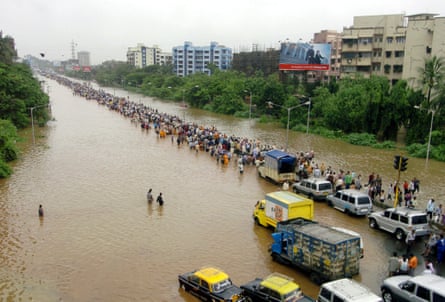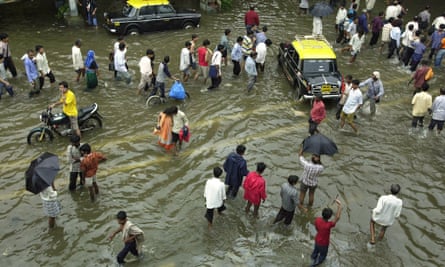Any discussion of floods in Mumbai begins with a ritual invocation of one fateful date: 26 July 2005. On this day, the megacity received 944mm of rainfall – the average amount for the entire season, and a 100-year high. This, combined with high tides, set off a devastating flood in the city, much of which is built on low-lying land reclaimed in the 19th century. In the catastrophe that ensued, electricity, water supply, communication networks and public transportation were totally shut down; 1,493 people perished, more than 14,000 homes were destroyed, and the city incurred losses amounting to £1.2bn.
In response, in 2007, the municipality formulated the Greater Mumbai disaster management action plan, which identified the risks and vulnerabilities the city could face, including floods, earthquakes and cyclones; it also formed the Disaster Management Cell to co-ordinate relief and rescue efforts, and widened and deepened the Mithi River, which drains into the Arabian Sea. But environmentalists and researchers contend that too many factors which make Mumbai vulnerable to flooding remain: unabated construction on floodplains and coastal areas, as well as the continuing problem of storm-water drains and waterways being clogged by plastic garbage.

Much still remains to be done, but time is running out. Climate scientists predict that chances of a 2005-like flood could more than double in Mumbai by 2080, and the losses could triple. “We need preventive measures, rather than a Disaster Management Cell, when we know [flooding] is an extreme event we’re prone to,” says Rishi Aggarwal, an environmental activist involved in urban planning and mangrove conservation. “But we have not learned anything in 10 years. For the past year, I’ve been involved in the development plan for Greater Mumbai, and there is no discussion on land use, like flood-prone areas where construction should be avoided.”
Last October, the Intergovernmental Panel on Climate Change (IPCC) portended an increase in rainfall, heat, humidity and sea-level rise that led them to rate Mumbai as the second most at-risk city among 50 worldwide, according to risk consultancy Maplecroft’s climate change vulnerability index. “Although the development of new drainage infrastructure in the city is underway,” the report noted, “the project is behind schedule and over-budget, demonstrating that the implementation of adaptive measures may still be a challenge for the local government.”
The report observed that unchecked development would also expose more people and assets to the ravages of climate change. “Currently, 2.8 million inhabitants in Mumbai are exposed to coastal flooding, but this figure projected to increase to 11 million by 2070, with exposed assets growing from $46.2bn to $1.6tn in the same period.” The report also added that certain actions, like indiscriminate clearing of mangrove forests, had escalated the city’s flood risk and lead to a three-fold increase in run-off.

The majority of deaths in the 2005 flood occurred in informal settlements, which are home to more than half of Mumbai’s population. “Slum-dwellers occupying low-lying precarious land are the most vulnerable to environmental stresses and flooding events,” says urban geographer Colin McFarlane, who has studied water and sanitation issues in the worst-hit slums towards the west and east of the city. “But what was striking to me was that there was a triple injustice enacted upon them: first, the flooding circulated rubbish and human waste around the slum, leading to outbreaks of malaria, dengue, leptospirosis, and general ill health since people had less access to food, water, medicine, and healthcare, and emergency services neglected these areas, focusing on middle-class neighbourhoods. Second, compensation was offered in a haphazard way – for example, it could often only be accessed through people who had the right sorts of contacts. Lastly, slums are often blamed for the actual flooding, and that can enter into justifications for demolition.” With climate change increasing the risks of these disasters, and squeezing finite resources, McFarlane fears that these triple injustices will only deepen.
Some of the worst-hit regions in 2005 lay along the Mithi River, a waterway clogged by silt, plastic and sewage that runs through the thickly populated and industrial areas of the city before draining into the Arabian Sea. In 2004, Rakesh Kumar, chief scientist at the Mumbai-based National Environmental Engineering Research Institute, had released a report that predicted these areas would be badly affected in the event of a flood. “There were, and still are, two reasons for this vulnerability,” Kumar says. “First, heavy rainfall events are increasing in frequency every year, which is attributed to climate change. Second, our infrastructure in terms of stormwater drains and natural drains like wetlands are being constricted and getting encroached upon.” Some of the flooded areas were on new developments along the riverbanks, atop mangrove forests that had once slowed the approach of seawater and could absorb excess water. “We’ve been saying wetlands and mangroves need to be looked at as vital infrastructure of the city, like a water or sewage treatment plant, something that will prevent disasters.”

Since 2013, Narayanan Vasudevan, the head of Mumbai’s Mangrove Cell and a marine biologist by training, has been charged with managing and protecting 5,469 hectares of this vital natural infrastructure in Mumbai and the suburban reaches of Navi Mumbai. Sophisticated satellite mapping has made the task easier by identifying the location and extent of mangrove ecosystems now designated as protected forestland. But it also reveals how frustratingly futile the task can be in a land-hungry megacity, by constantly throwing up glimpses of parking lots, temples and garbage dumps popping up where mangroves used to be. “Half the mangroves are on private land,” says Vasudevan, “so we have no control over them. Also, Mumbai is a developing city, and all the debris from buildings being knocked down needs to go somewhere.”
The problem is that these debris dumps lay the ground for illegal reclamation of land, in flagrant violation of a law restricting construction on coastal areas. Earlier this year, a few environmental groups had brought a number of these violations to the Bombay High Court’s attention, and the court directed Vasudevan to visit the site. The violations he recorded in his report included shrinking lakes and wetlands, as well as reclaimed land upon which parking lots, temples, slums and even a road had been constructed. In the report, Vasudevan notes: “[Some] areas are witnessing destruction of coastal wetlands at a feverish pitch through incessant dumping of debris. Several new apartment complexes have cropped up, indicating the seriousness of the threat from real estate developers.”
Stalin Dayanand from Vanashakti, an environmental group that petitioned at the High Court, thinks that nothing will change so long as affordable housing is not constructed for migrants, who crowd into low-lying areas near deltas and on sinking coasts, and so long as the developer-politician nexus continues. He accuses politicians and local administrators of “regularising environmental violations by builders”, and of stalling the release of a contour map that would demarcate high-tide zones where construction would be hazardous. “The map was submitted six months ago, they’re not going to let it get through to the public until it’s pointless, and there are multi-storeyed monsters everywhere,” he says.
“This year, the tide breached the Gateway of India. It’s a wake-up call. But you can wake up someone only if they’re sleeping, not if they’re pretending to sleep. The Corporation is too busy making money to notice.”
